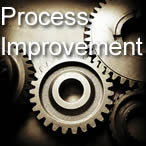Lean Business starts with the Voice of the Customer (VOC)
|
The implementation of a Lean Philosophy in any business is a continuous 5-stage process that begins with the identification of the value desired by the customers. Unfortunately, this old marketing concept is frequently forgotten during Lean implementation as suppliers and service providers regularly introduce new products and services that are constrained by their own internal demands and their existing facilities and paradigms, rather than by actual customer requirements. |
|||
|
|||
|
Far too often companies, whether manufacturing or service orientated, work on the assumption that they know exactly what their customer needs, or they give their customers what happens to be convenient to them, e.g. automated telephone answering systems that reduce costs to the provider but infuriate customers, or goods packaged in containers and in quantities that suit the manufacturer, but not the customer. While many companies often know who the key decision makers are in the customer organisation, few actually understand the individual value criteria that influence their buying decision making. True customer satisfaction is achieved only when suppliers meet or exceed the customer’s expectation against a range of customer-specified value criteria. |
|||
|
While customers do want price, quality and delivery (PQD), there are a host of other factors that can influence buying decisions, e.g. packaging & labeling, invoicing, design flexibility, communication (including methods, speed, style, documentation etc), quotations, after sales service, environmental issues, lead time reliability, technical support, safe handling, product/packaging disposal, and payment terms. By conducting a detailed customer needs analysis with the relevant decision makers, i.e. those people that come into contact with the product or service and are able to influence buying behaviour, many companies are surprised to find that the actual customer needs are quite different to their perception of these needs as is depicted below. |
|||
Determining the actual customer-specified values depends on the number of customers and relationship that the company or service provider has with these customers, i.e. a) Direct relationship with relatively few customers, as is the case with a typical manufacturing company that supplies other manufacturers or the wholesale trade. b) Indirect relationship with many customers, as is the case where goods are sold to the mass market via retail outlets. The first case lends itself to conducting direct interviews with the various decision makers within the customer organisation, asking them to identify their personal value criteria and then ranking your performance relative to your competitors or the ‘best in class’. Where the decision maker has identified numerous needs or values, these should then be ranked in order of importance. In the second case where there is only an indirect relationship with the customers, market surveys, focus groups, warranty repair data and customer feedback forms typically become the data source for determining customer value criteria. Any customer needs analysis should be conducted with a representative group of existing customers (high, medium and low volume), and should also include potential customers. Be sure to include the following two aspects of product or service delivery, i.e. * Pre-Ordering: Listening to the customer to understanding what is important to them before they place an order. Having collected the data, collate and plot the results to determine the most important value criteria, and then establish action plans to address shortcomings within your organisation. Only after having listened to the voice of the customer to understand the true value of the product or service from the customer’s point of view, can the supplier continue down the path of Lean and identify those internal processes that contribute, or add value to that product or service, i.e. stage 2 – identifying the value stream for each product or service group. This is the sequence of all current processes, both value adding and non-value adding from raw material to product launch or from initial customer contact to service completion. In doing so, the non-value adding processes will automatically be identified which allows the supplier to progress to stages 3 and 4 in the Lean implementation, and use the various Lean tools and techniques to reduce and ultimately eliminate the non-value adding processes. Having completed an initial cycle of the Lean implementation, the process constantly repeats itself in a never-ending quest for perfection. For further information, contact Mike Karle ( mike.karle@informgroup.com.au) |
|||










